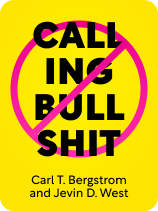

This article is an excerpt from the Shortform book guide to "Calling Bullshit" by Carl T. Bergstrom and Jevin D. West. Shortform has the world's best summaries and analyses of books you should be reading.
Like this article? Sign up for a free trial here.
When you recognize lies and misinformation, do you call them out? Do you have the guts to do it but lack the skills to counter false claims?
Carl T. Bergstrom and Jevin D. West acknowledge that identifying bullshit alone isn’t enough to mitigate its spread. To that end, they share several techniques for calling bullshit so that others don’t fall for it: Construct a reductio ad absurdum, provide counterexamples, and use clarifying analogies.
Read more to learn how to call BS and keep misinformation at bay.
How to Call BS
Bergstrom and West define bullshit as the use of misleading evidence, without regard for the truth, to sway an audience by confusing or overwhelming them. This definition, they point out, has two key aspects. First, the bullshitter appeals to evidence that obscures the truth, rather than illuminating it. For example, this might involve using bombastic language that makes it difficult for an audience to follow the argument. Alternatively, this could involve using statistics or data taken out of context.
Let’s explore three strategies for calling BS that Bergstrom and West recommend.
Strategy #1: Construct a Reductio ad Absurdum
Bergstrom and West explain that a reductio ad absurdum (“reduction to absurdity”) can be a powerful tool for calling BS. Constructing a reductio ad absurdum involves showing that a claim has an obviously false consequence, and thus logically cannot be true. For example, imagine that you read an op-ed arguing that parents should have absolutely no restrictions on how they choose to raise their children. In this case, you could construct a reductio ad absurdum pointing out that this op-ed’s view implies that parents should have the right to abuse or neglect their children. Because this implication is ridiculous, the original view must be false.
Strategy #2: Provide Counterexamples
A similar technique for calling BS involves providing counterexamples to bullshit claims. To provide a counterexample, point out a situation in which a bullshit theory or claim makes a false prediction. For instance, if someone made the sweeping claim that you must get a college education to make a good living, you could provide a counterexample by pointing to the many millionaire entrepreneurs who don’t have degrees. Counterexamples thus provide a simple way to refute bullshit generalizations.
(Shortform note: Although Bergstrom and West write as if counterexamples are wholly distinct from reductio ad absurdum, the two are actually close relatives. After all, we can understand counterexamples as exposing an absurd consequence of a given view. For instance, the counterexample of millionaires without college degrees underscores a false consequence of the view that you need a college education to be successful—namely, that all millionaires have college degrees.)
Strategy #3: Use Clarifying Analogies
Finally, Bergstrom and West argue that analogies can be a useful tool for shedding light on bullshit that hides in seemingly plausible claims. To provide an analogy that exposes bullshit in an argument, create an argument that parallels the bullshit argument but is clearly invalid. For example, imagine that several parents defended the decision to spank children on the grounds that they had spanked their children without any adverse effects. To underscore why this argument is bullshit, you could offer an analogous defense of drunk driving that notes that many people who drive drunk don’t get into car crashes. This analogy makes it clear that just because a practice sometimes has no adverse effects, that doesn’t mean it’s a good practice.
(Shortform note: Philosophers have identified a wide array of commonsense guidelines for assessing how strongly an analogy supports a given conclusion. For example, analogies between two arguments (or domains) that have deep structural similarities are more powerful than those between two arguments which are only superficially similar. Further, providing multiple apt analogies is more persuasive because, while you might find one analogy by sheer coincidence, you’re less likely to find several analogies by chance alone.)
Exercise: Practice Calling BS
In their book, Bergstrom and West provide an array of strategies both for identifying and calling BS. In this exercise, practice implementing these strategies to refute bullshit online and in the news.
- Think about some recent news stories you’ve encountered that seem likely to contain bullshit. Describe some of the specific claims you think might be bullshit.
- Pick one of Bergstrom and West’s three strategies for refuting bullshit (construct a reductio ad absurdum, provide counterexamples, use clarifying analogies) to call BS on the claim. Why do you think the strategy you chose is effective?

———End of Preview———
Like what you just read? Read the rest of the world's best book summary and analysis of Carl T. Bergstrom and Jevin D. West's "Calling Bullshit" at Shortform.
Here's what you'll find in our full Calling Bullshit summary:
- That misinformation online, in news, and in academia is spreading
- How to detect and refute bullshit in its many forms
- How data can be miscollected and misinterpreted in science






